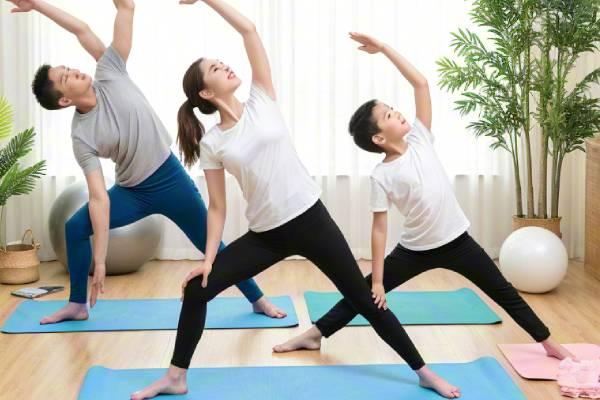Benefits of family yoga practice
The Transformative Benefits of Family Yoga Practice
Family yoga is more than just a physical activity; it’s a holistic practice that fosters connection, mindfulness, and well-being for all ages. Integrating yoga into family life offers a unique opportunity to bond, grow, and thrive together. Below are the key benefits of practicing yoga as a family:

1. Strengthens Family Bonds
-
Shared Experience: Yoga creates a non-competitive space where families engage in synchronized movements, breathing exercises, and relaxation, fostering teamwork and mutual support.
-
Quality Time: In today’s fast-paced world, family yoga carves out intentional time to unplug from screens and distractions, allowing parents and children to connect authentically.
-
Communication: Partner poses (e.g., "double tree pose") and group activities encourage verbal and non-verbal communication, enhancing trust and understanding.
2. Promotes Physical Health for All Ages
-
Flexibility & Strength: Yoga postures improve balance, coordination, and muscle tone, benefiting both children’s developing bodies and adults’ mobility.
-
Healthy Habits: Introducing yoga early encourages kids to view exercise as fun and rewarding, laying the groundwork for lifelong fitness.
-
Breath Awareness: Pranayama (breathing techniques) teaches families to regulate their breath, boosting lung capacity and reducing stress.
3. Enhances Emotional Well-Being
-
Stress Reduction: Yoga’s calming effects lower cortisol levels, helping both parents and children manage anxiety, school pressure, or work-related stress.
-
Emotional Regulation: Mindfulness practices in yoga teach kids to recognize and process emotions, while adults gain tools to model patience and resilience.
-
Joyful Expression: Playful poses (e.g., "lion’s breath" or "downward dog") invite laughter, releasing endorphins and fostering a positive atmosphere.
4. Cultivates Mindfulness & Focus
-
Present-Moment Awareness: Family yoga encourages mindfulness through guided meditation or mindful movement, improving concentration in children and adults alike.
-
Reduces Overstimulation: In a world filled with sensory overload, yoga offers a grounding practice to reset the nervous system and restore mental clarity.
5. Fosters Inclusivity & Adaptability
-
All Skill Levels Welcome: Yoga is adaptable to any age or ability, allowing grandparents, toddlers, and teens to participate at their own pace.
-
Celebrates Differences: Families learn to embrace each member’s unique strengths, promoting self-acceptance and mutual respect.
6. Builds Lifelong Values
-
Gratitude & Compassion: Closing sessions with gratitude circles or affirmations nurture empathy and appreciation within the family unit.
-
Resilience: Challenging poses teach perseverance, while restorative poses emphasize the importance of rest and self-care.
7. Creates Lasting Memories
Family yoga rituals—whether a weekly session or a sunrise practice on vacation—become cherished traditions that children carry into adulthood.
Getting Started Tips:
-
Keep sessions short (15–30 minutes) and playful for younger kids.
-
Use themed sessions (e.g., "animal poses" or "space adventure yoga") to engage imaginations.
-
Incorporate music, storytelling, or nature (outdoor yoga!) to enhance the experience.
By embracing family yoga, households cultivate a sanctuary of calm, health, and connection. It’s not just about bending and stretching—it’s about growing together in body, mind, and spirit.
How Family Yoga Works: A Guide to Building Connection, Play, and Wellness Together
Family yoga is a collaborative, adaptable practice designed to engage all ages, from toddlers to grandparents. Unlike traditional yoga classes, it prioritizes connection over perfection, playfulness over rigidity, and inclusivity over individual achievement. Here’s how it works:
1. Structure of a Family Yoga Session
Family yoga sessions are flexible but often follow a rhythm that balances movement, mindfulness, and fun:
-
Warm-Up (5–10 minutes):
-
Start with gentle stretches, playful breathing exercises (e.g., "balloon breaths"), or a game like "follow the leader" to energize the group.
-
-
Movement & Poses (15–20 minutes):
-
Incorporate age-appropriate poses:
-
Kids: Animal-inspired poses (e.g., "frog jumps," "downward dog," "cobra").
-
Adults/Grandparents: Gentle stretches, warrior poses, or seated twists.
-
Partner/Group Poses: Double tree pose, group "boat pose," or family "bridge" formations.
-
-
-
Mindfulness & Relaxation (5–10 minutes):
-
Guided visualization, storytelling meditations, or a quiet "Savasana" (resting pose) with soft music.
-
End with a gratitude circle or affirmations (e.g., "I am strong," "We are kind").
-
2. Key Elements That Make It Work
-
Adaptability:
-
Sessions adjust to the youngest or least experienced participant. For example:
-
Toddlers: Short attention spans? Use 5-minute yoga "snacks" with songs or stories.
-
Teens: Incorporate flow sequences or mindfulness challenges.
-
-
-
Playfulness:
-
Turn poses into games: "Yoga freeze dance," obstacle courses with mats, or "yoga charades."
-
Use props like stuffed animals, hula hoops, or DIY "mindfulness jars" to spark engagement.
-
-
Shared Leadership:
-
Let kids take turns leading poses or choosing themes (e.g., "under the sea yoga," "superhero flows").
-
-
Non-Competitive Atmosphere:
-
Focus on effort, not perfection. Celebrate wobbles and laughter as part of the process.
-
3. How It Bridges Generations
-
Multigenerational Poses:
-
Grandparents can guide seated stretches while grandkids mimic animal poses nearby.
-
Partner poses (e.g., "back-to-back breathing") foster physical touch and trust.
-
-
Mindfulness for All:
-
Simple practices like "flower breath" (smelling imaginary flowers) work for all ages, teaching emotional regulation in a relatable way.
-
4. Creating a Safe, Inclusive Space
-
Physical Safety:
-
Use non-slip mats, clear space for movement, and avoid overly complex poses for beginners.
-
-
Emotional Safety:
-
Encourage open communication: "No pose is mandatory—modify or rest as needed."
-
Validate feelings: "It’s okay to feel silly!" or "Let’s try that pose again together."
-
5. Building a Routine
-
Consistency Over Length:
-
Even 10-minute sessions 2–3 times a week can build habits.
-
-
Themes & Rituals:
-
"Mindful Mondays," "Friday Dance-Yoga Fusion," or seasonal themes (e.g., "garden yoga" in spring).
-
-
Integrate into Daily Life:
-
Practice "waiting-in-line yoga" (balance poses) or "calm-down breaths" before homework.
-
6. Tools & Resources
-
Apps/YouTube: Family-friendly channels like Cosmic Kids Yoga or Yoga Pretzels cards.
-
DIY Props: Pillows for meditation, scarves for breathwork, or nature items (pinecones, leaves) for sensory play.
Why It Works:
Family yoga thrives because it meets everyone where they are. It’s not about mastering poses but:
-
Creating moments of joy and presence.
-
Teaching resilience through playful challenges.
-
Modeling self-care and mindfulness as a shared value.
Key Takeaway:
Family yoga works because it’s a living practice—evolving with your family’s needs, energy, and creativity. Whether you’re laughing through a wobbly "airplane pose" or bonding in silent meditation, it’s the shared journey that matters most.





